Discover 15 hidden attractions, cool sights, and unusual things to do in Tiruchirappalli (India). Don't miss out on these must-see attractions: Ucchi Pillayar Temple, Ranganathaswamy Temple, and Jambukeswarar Temple. Also, be sure to include Tiruchirappalli Rock Fort in your itinerary.
Below, you can find the list of the most amazing places you should visit in Tiruchirappalli (Tamil Nadu).
Table of Contents
Ucchi Pillayar Temple
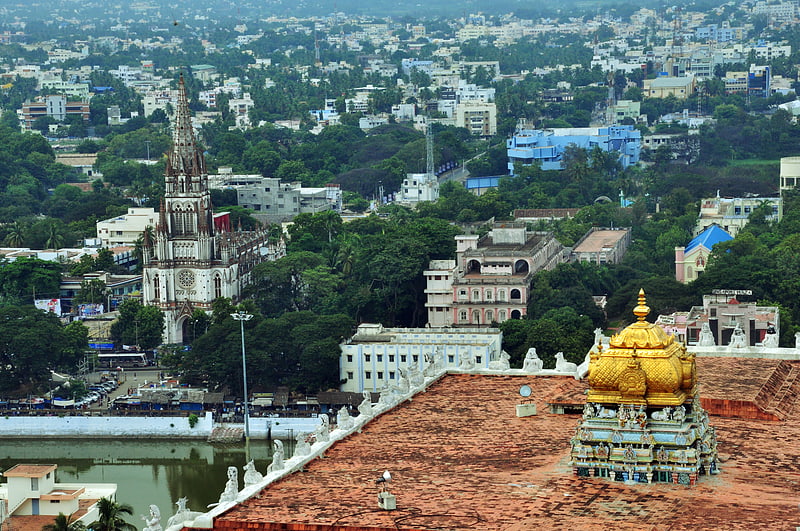
Hindu temple in Tiruchirappalli, India. Ucchi Pillayar Temple is a 7th-century Hindu temple, one dedicated to Lord Ganesha located a top of Rockfort, Trichy, Tamil Nadu, India. According to legend, this rock is the place where Lord Ganesha ran from King Vibishana, after establishing the Ranganathaswamy deity in Srirangam. Tiruchirapalli Rock Fort is also fondly called as Malaikottai in Tamil.[1]
Address: N Andar St, 620002 Tiruchirappalli
Ranganathaswamy Temple
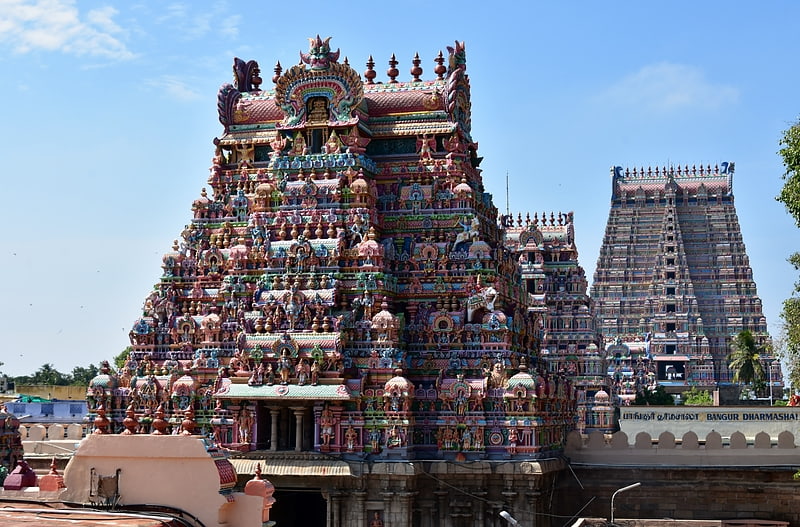
Also known as: श्री रंगनाथस्वामी मंदिर, श्रीरंगम
Hindu temple in Tiruchirappalli, India. The Sri Ranganathaswamy Temple is a Hindu temple dedicated to Ranganatha, a form of the Supreme God, Maha Vishnu, located in Srirangam, Tiruchirapalli, Tamil Nadu, India. Constructed in the Hindu architectural style, the temple is glorified by Alvars in their Divya Prabhanda and has the unique distinction of being the foremost among the 108 Divya Desams dedicated to The Supreme God Vishnu.
It is the most illustrious Vaishnava temples in South India rich in legend and history. The temple has played an important role in Vaishnavism history starting with the 11th-century career of Ramanuja and his predecessors Nathamuni and Yamunacharya in Srirangam. Its location, on an island between the Kollidam and Kaveri rivers, has rendered it vulnerable to flooding as well as the rampaging of invading armies which repeatedly commandeered the site for military encampment. The temple was looted and destroyed by the Delhi Sultanate armies in a broad plunder raid on various cities of the Pandyan kingdom in early 14th century. The temple was rebuilt in late 14th century, the site fortified and expanded with many more Gopurams in the 16th and 17th centuries. It was one of the hubs of early Bhakti movement with a devotional singing and dance tradition, but this tradition stopped during the 14th century and was revived in a limited way much later.
The temple occupies an area of 155 acres (63 ha) with 81 shrines, 21 towers, 39 pavilions, and many water tanks integrated into the complex making it the world's largest functioning Hindu temple. The temple town is a significant archaeological and epigraphical site, providing a historic window into the early and mid medieval South Indian society and culture. Numerous inscriptions suggest that this Hindu temple served not only as a spiritual center, but also a major economic and charitable institution that operated education and hospital facilities, ran a free kitchen, and financed regional infrastructure projects from the gifts and donations it received.
The Srirangam temple is the largest temple compound in India and one of the largest religious complexes in the world. Some of these structures have been renovated, expanded and rebuilt over the centuries as a living temple. The latest addition is the outer tower that is approximately 73 metres (240 ft)tall, completed in 1987. Srirangam temple is often listed as one of the largest functioning Hindu temple in the world, the still larger Angkor Wat being the largest existing temple. The temple is an active Hindu house of worship and follows Thenkalai tradition of Sri Vaishnavism. The annual 21-day festival conducted during the Tamil month of Margazhi (December–January) attracts 1 million visitors. The temple complex has been nominated as a UNESCO World Heritage Site, and is in UNESCO's tentative list.[2]
Jambukeswarar Temple
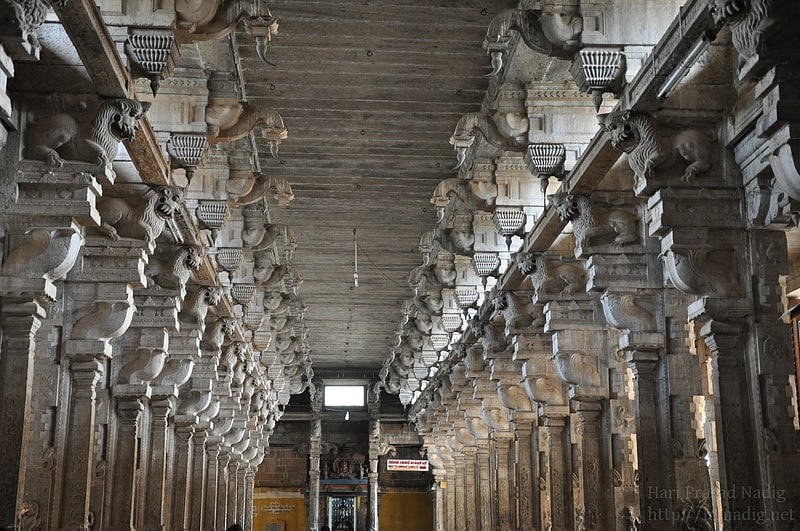
Also known as: अकिलन्देश्वरी मन्दिर, तिरुवनैकवल
Hindu temple in Tiruchirappalli, India. Jambukeswarar Temple, Thiruvanaikaval is a famous Shiva temple in Tiruchirapalli district, in the state of Tamil Nadu, India. Though it is that Kocengannan, one of the Early Cholas, have built this temple. It is located in the Srirangam island, which has the famous Ranganathaswamy temple.
Thiruvanaikal is one of the five major Shiva Temples of Tamil Nadu (Pancha Bhoota Stalam) representing the Mahābhūta or five great elements; this temple represents the element of water, or neer in Tamil. The sanctum of Jambukeswara has an underground water stream and in spite of pumping water out, it is always filled with water.
It is one of the 275 Paadal Petra Sthalams, where all the four most revered Nayanars (Saivite Saints) have sung glories of the deity in this temple. The temple has inscriptions from the Chola period.[3]
Address: N Car St, 620005 Tiruchirappalli
Tiruchirappalli Rock Fort
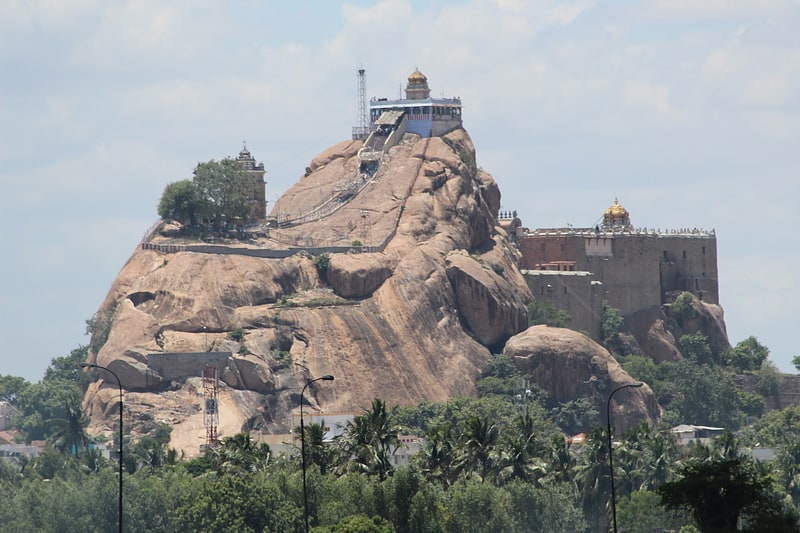
Fortification in Tiruchirappalli, India. Tiruchirappalli Rockfort, locally known as Malaikottai, is a historic fortification and temple complex built on an ancient rock. It is located in the city of Tiruchirappalli, on the banks of river Kaveri, Tamil Nadu, India. It is constructed on an 83 metres high rock. There are two Hindu temples inside, the Ucchi Pillayar Temple, Rockfort and the Thayumanaswami Temple, Rockfort. Other local tourist attractions include the famous Pallava-era Ganesha temple and the Madurai Nayak-era fort. The fort complex has witnessed fierce battles between the Madurai Nayakas and Adil Shahi dynasty of Bijapur, Carnatic region and Maratha Imperial forces. The fort played an important part during the Carnatic Wars, helping lay the foundations of the British Empire in India. The Rockfort is the most prominent landmark of the city.[4]
Our Lady of Lourdes Church
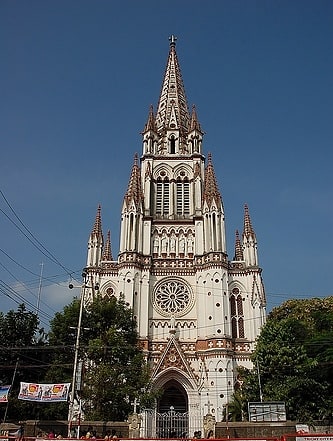
Catholic church in Tiruchirappalli, India. The Our Lady of Lourdes Church is located in the city of Tiruchirapalli in the state of Tamil Nadu, India. Built in the Gallo-Catholic design, the Church is devoted to Our Lady of Lourdes. The church is considered one of oldest of the 22 churches in the city which are older than 100 years. The church is located in the premises of St. Joseph's College Higher Secondary School, Trichy. The church is one of the major landmarks in the city.
The foundation was laid during 1895 and the construction completed by 1903 when it was thrown open to public. The images of St. Ignatius, St. Francis Xavier, Sacred Heart of Jesus, St. Peter, and St. John de Britto on the middle of the spire is the most notable feature of the church. The renovated church was dedicated on 10 February 1998 and the Way of cross was blessed and erected during 1999. The church presents a case study of a Gothic style church built fully with indigenous material and craftsmen.
Our Lady of Angels Church is a working church with hourly prayer and daily services and follows Roman Catholic sect of Christianity. The church has various religious practices from 5:15 am to 8 pm. There are four annual feasts in the church with the feast of Our Lady of Lourdes held annually on 11 February being the most prominent among them. The church is associated with the Roman Catholic Diocese of Tiruchirapalli, while it is maintained and administered by the Fathers of Society of Jesus (The Jesuits).[5]
Address: College Rd, 620002 Tiruchirappalli
Upper Anaicut
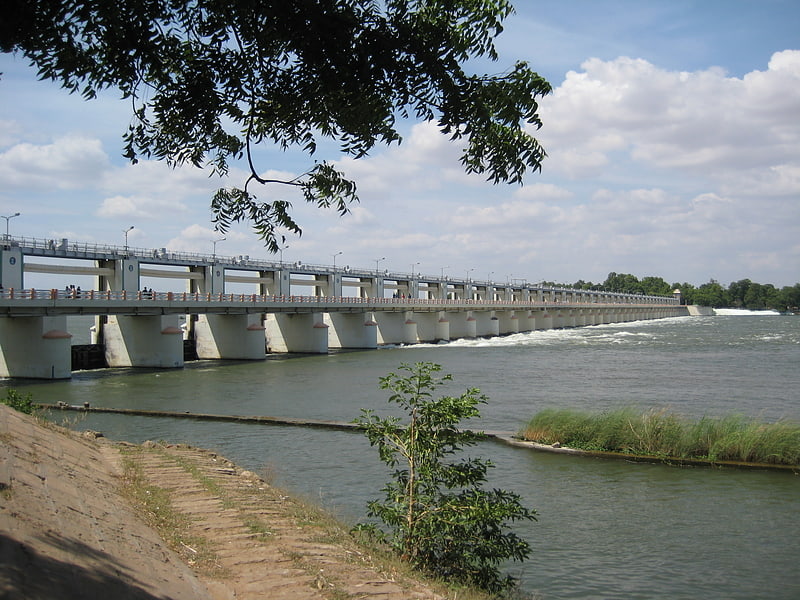
The Upper Anaicut, also known as Mukkombu is a dam built on the Kaveri River in the state of Tamil Nadu in southern India. The regulator dam was constructed between 1836 and 1838 by Sir Arthur Cotton, a British irrigation engineer who was inspired by the architectural beauty of Grand Anaicut canal built by Karikala Chola in Kallanai of Thanjavur district in the second century.
Upper Anaicut or Mukkombu is about 18 kilometers (11 mi) west of Trichy and 2 kilometers away from Jeeyapuram at a point where River Kollidam branches out from the main river, Cauvery. It is a lovely picnic spot skirting acres of verdant greenery. The place also has a well-manicured park. Mukkombu is about 685-meter long (2283 foot),
It breaks into two channels at the Upper Anaicut to form the island of Srirangam, which is enclosed in between the delta of Thanjavur (Tanjore), the garden of Tamil Nadu.[6]
Kallanai Dam

Kallanai is an ancient dam. It is built across the Kaveri river flowing from Tiruchirapalli District to Thanjavur district,Tamil Nadu, India. The dam located in Trichy district. Located at a distance of 15 km from Tiruchirapalli, 45 km from Tanjavur, the dam was originally constructed during the reign of Chola king Karikalan in c.150 AD. It is the fourth oldest water diversion or water-regulator structures in the world and the oldest in India that is still in use. Because of its spectacular architecture, it is one of the prime tourist spots in Tamil Nadu.[7]
Uyyakondan Thirumalai Temple
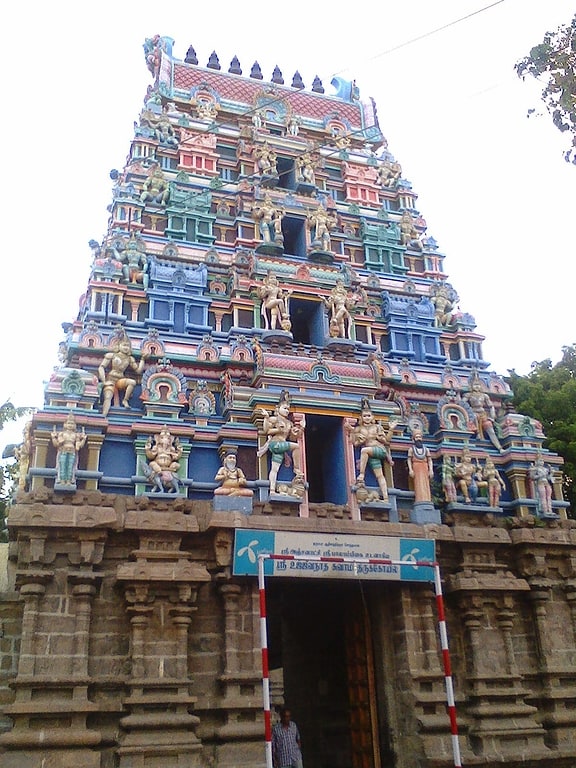
Hindu temple in India. Uyyakondan Thirumalai Temple) is a Hindu temple dedicated to the deity Shiva, located on the banks of Uyyakondan river, Trichy, in the South Indian state of Tamil Nadu. Shiva is worshipped as Uyyakondan, and is represented by the lingam. His consort Parvati is depicted as Anjanakshi Amman. The presiding deity is revered in the 7th century Tamil Saiva canonical work, the Tevaram, written by Tamil saint poets known as the Nayanars and classified as Paadal Petra Sthalam.
The temple complex covers four acres, constructed on a hillock 30 m (98 ft). The temple has a number of shrines, with those of Uyyakondar and his consorts Maivizhi and Kanniyumaiyal, being the most prominent. All the shrines of the temple are enclosed in large concentric rectangular granite walls. The temple is approached by a flight of steps from the basement that houses the temple tank.
The temple has four daily rituals at various times from 6:00 a.m. to 8:30 p.m. and four yearly festivals on its calendar. The Brahmotsavam festival is celebrated during the day of the Panguni (March -April) is the most prominent festival.
The original complex is believed to have been built by Cholas. In modern times, the temple is maintained and administered by the Hindu Religious and Charitable Endowments Department of the Government of Tamil Nadu. The temple has inscriptions from the Chola period.[8]
Address: No-203, Vayalur Rd, 620102 Tiruchirappalli
Tropical butterfly conservatory
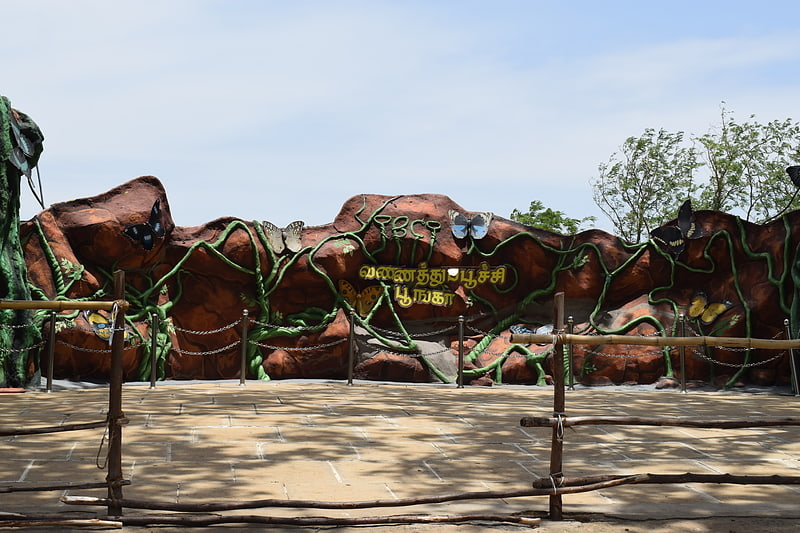
The Tropical Butterfly Conservatory, is located in the Upper Anaicut reserve forest in Srirangam. It covers 25 acres. The conservatory lies in the river Cauvery and Kollidam drainage basin. The Conservatory consists of Butterfly Park and Nakshatravanam. The conservatory falls under Tiruchirappalli Forest Division. This park is the largest butterfly park in Asia[9]
Government Museum
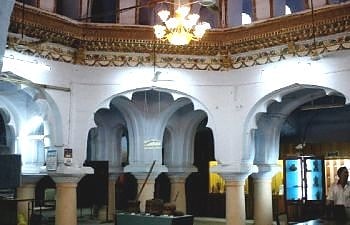
Museum. The Government Museum, Tiruchirappalli is a heritage centre at Tiruchirappalli, Tamil Nadu.It is situated at Rani Mangammal Mahal in Bharathidasansan town, near the super bazaar.The nearest landmark is Rockfort temple.
Rani Mangamma Mahal was built by Chokkanatha Nayak, the then ruler of Madurai. It was also known as the Durbar Hall of the Madurai Nayaks when Tiruchirapally was their capital, from 1616 to 1634 and later from 1665 to 1731.
The museum contains array of exhibits relating to geology, zoology, paintings, anthropology, epigraphy and history.[10]
Vayalur Murugan Temple
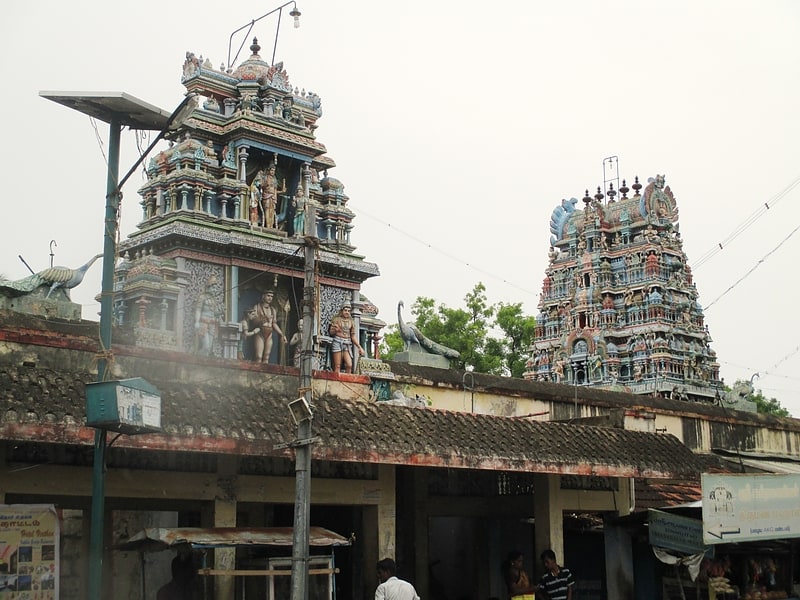
Hindu temple in India. The Vayalur Murugan Temple is a Hindu temple dedicated to Muruga, son of Lord Shiva and Parvati, located in the village of Kumaravayalur in Tiruchirapalli district, Tamil Nadu, India. The temple is believed to have been initiated during the period of Medieval Cholas during the 9th century. The temple is maintained and administered by the Hindu Religious and Charitable Endowments Department of the Government of Tamil Nadu. Though the presiding deity is Shiva, the temple is known for the Murugan shrine. The temple is associated with Hindu savant, Kirupanandha Variyar.[11]
Srirangam
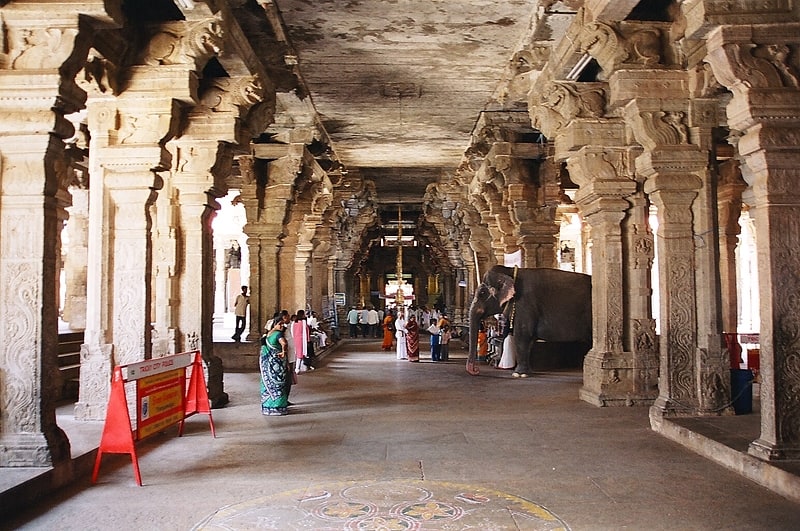
Also known as: श्रीरंगम
City in Srirangam Island, India. Srirangam also known as Thiruvarangam, is an island of the city of Tiruchirappalli and a part of Tiruchirappalli Metropolitan Area in the Indian state of Tamil Nadu. A river island, Srirangam is bounded by the Kaveri River on one side and its distributary Kollidam on the other side. Considered as the first among the 108 Divya Desams, Srirangam is home to a significant population of Sri Vaishnavites.[12]
Thayumanaswami Temple
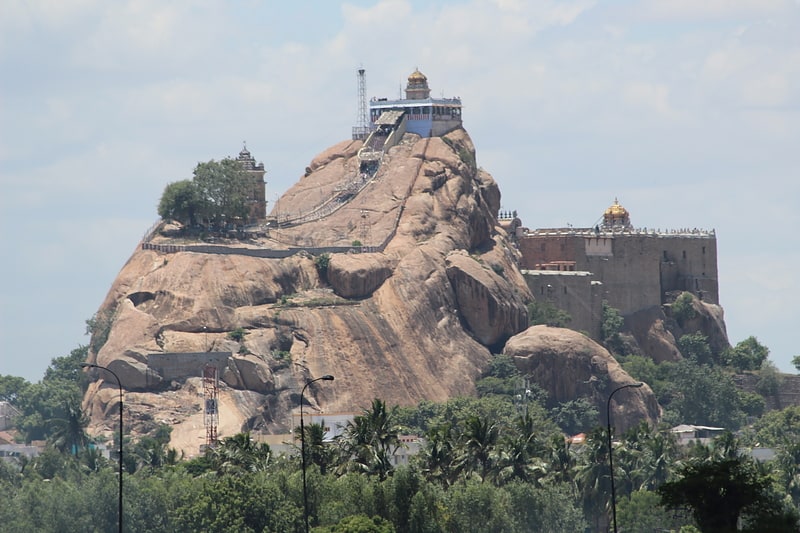
Hindu temple in Tiruchirappalli, India. The Thayumanavar Temple is a temple situated in the Rockfort complex in the city of Tiruchirappalli, India. Shiva is worshiped as Thayumanavar, and is represented by the lingam and his consort Parvati is depicted as Mattuvar Kuzhalammai. The presiding deity is revered in the 7th century Tamil Saiva canonical work, the Tevaram, written by Tamil saint poets known as the nayanars and classified as Paadal Petra Sthalam.
According to Hindu legend, a pregnant woman named Rathnavathi was an ardent devotee of Shiva and he arrived in the form of her mother to attend to her delivery. The presiding deity is thus named Thayumanaswamy, the one who acted as mother. The Rockfort is a fortress which stands atop a 273-foot-high rock, consisting of a set of monolithic rocks accommodating many rock-cut cave temples. Originally built by the Pallavas, it was later reconstructed by the Madurai Nayaks and Vijayanagara rulers. The major complex in the temple are believed to be built during the 8th century by the Pandyan Empire.
The temple has six daily rituals at various times from 5:30 a.m. to 10 p.m. and twelve yearly festivals on its calendar. The Chittirai festival during the Tamil month of Chittirai (April - May) is celebrated for fifteen days, portraying the various incidents associated with the temple legend. The temple is maintained and administered by the Hindu Religious and Charitable Endowments Department of the Government of Tamil Nadu.[13]
Address: South Street, 620002 Tiruchirappalli
Erumbeeswarar Temple
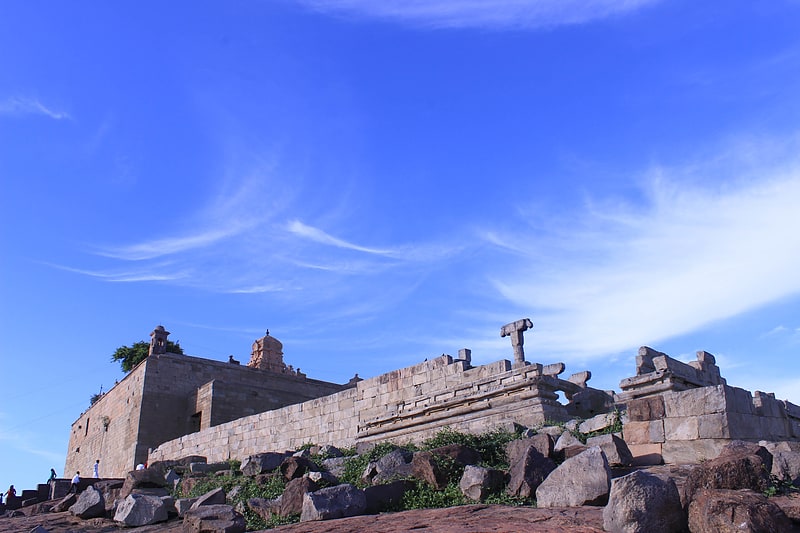
Hindu temple in Thiruverumbur, India. Erumbeeswarar Temple in Thiruverumbur, Tamil Nadu, India, is a Hindu temple dedicated to the deity Shiva. Built on a 60-foot tall hill, it is accessible via a flight of steps. The temple's main shrines and its two prakarams are on top of the hill, while a hall and the temple tank are located at the foothills. Shiva is believed to have transformed himself into an ant hill and tilted his head at this place to enable ants to climb up and worship him. Erumbeeswarar is revered in the canonical 7th-century Tamil Saiva work the Tevaram, written by Tamil saint poets known as nayanmars and classified as Paadal Petra Sthalam.
The temple is one in a series built by Aditya Chola (871-907 CE) along the banks of river Cauvery, to commemorate his victory in the Tirupurambiyam Battle. It has several inscriptions from the Chola Empire dating back to the 10th century. The temple has been declared a protected monument by the Archaeological Survey of India and is locally referred as "Kailash of South India". The temple has six daily rituals at various times from 5:30 am to 8:00 pm, and three yearly festivals in its calendar. The annual Brahmotsavam (prime festival) is attended by thousands of devotees from far and near. Every full moon, tens of thousands of pilgrims worship Erumbeeswarar by circumambulating the hill barefoot in a practise called girivalam. The temple is maintained and administered by the Hindu Religious and Endowment Board of the Government of Tamil Nadu.[14]
Prasanna Venkatachalapathy Temple

Hindu temple in Gunaseelam, India. Gunaseelam Vishnu Temple is a Hindu temple dedicated to Vishnu located 20 km from Trichy, in the South Indian state of Tamil Nadu. It is located on the banks of river Kaveri. A visit temple is believed to be a curative to the mentally challenged people, who are taken to the temple and kept in the temple premises for 48 days. At the end of the 48 days it is believed that their illness is cured by the grace of the presiding deity, Prasanna Venkatachalapathi. The temple has set up a mental health rehabilitation centre that has the official stamp of the Tamil Nadu Government license, the first of its kind in Tamil Nadu.
The temple has six daily rituals at various times from 6:30 a.m. to 8:30 p.m. and three yearly festivals on its calendar. The annual Brahmotsavam (prime festival) is an eleven-day festival attended by thousands of devotees from far and near. The temple is maintained by a hereditary executive trustee.[15]
Address: State Highway 25, Tiruchirappalli